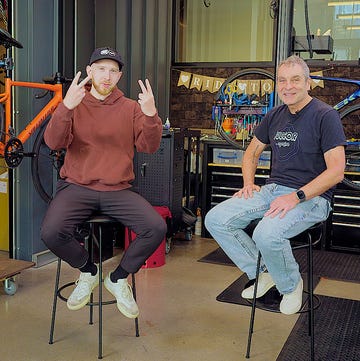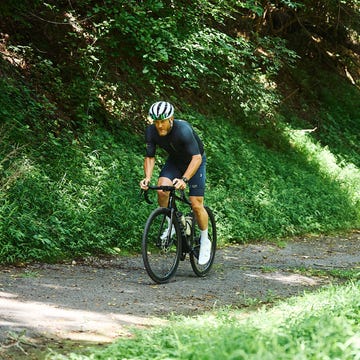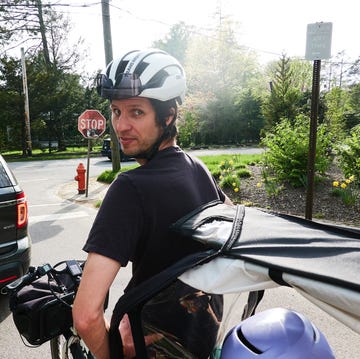Even when we ride regularly, and maintaining a solid strength-training routine, many cyclists suffer from lower back pain. Common culprits that may cause this pain include bike issues, lack of core strength, or not focusing enough on stretching and mobility. Another major culprit of lower back pain: sitting for hours a day, whether that’s at your desk, in your car, or on your bike.
One of the best ways to elevate lower back pain from sitting too much is to get up and move more often. But to eliminate this pain for good, the solution isn’t as simple as changing positions on the bike, correcting your posture, or going for a walk (though all those will help!).
For tips on alleviating lower back pain from sitting, we tapped Vinh Pham, licensed physical therapist and author of Sit Up Straight: Futureproof Your Body Against Chronic Pain with 12 Simple Movements. Read on to find out the root cause of this pain, and how Pham suggests you treat it.
Why Sitting Causes Lower Back Pain
About one in four American adults report sitting for more than eight hours a day, according to research published in The Journal of the American Medical Association in 2018.
While it’s difficult to study subjective sitting behaviors and positions across various bodies and workspace ergonomics, some research and experts report a link between sitting for long hours each day and lower back pain.
“Anything that you do that is repetitive feeds a pattern in your body, whether you’re sitting for eight hours at an office or standing at an office or hunched over your bike for one to two hours a day,” says Pham.
To that point, The Spine Journal published a report in 2018 that called out an association between sitting more than seven hours per day and lower back pain, particularly in people 50 years of age and older. That research also said the longer you sit, and the less active you are, the higher your risk for lower back pain.
Other research published in the Applied Ergonomics journal in 2019 also linked lower back pain and sitting, suggesting that uninterrupted, extended periods of any sitting position—even with good posture—is the negative culprit, leading to fatigue, pain, and discomfort.
According to the study, sitting without variation and without micro-movements leads to poor spinal health and lower back pain because static postures increase spinal load and shrinkage, as well as muscle fatigue. That lack of dynamic movement and posture variation can break down the intervertebral discs, which is the principal joint between two vertebrae in the spinal column—five are in the lumbar region of the lower back.
Each of the spine’s 23 discs have an exterior wall called the annulus fibrosus and an interior gel-like center—like “the jelly” of a doughnut, says Pham—called the nucleus pulposus. The discs absorb shocks to the body, protect the spine, and allow for mobility.
Oxygen is required to synthesize proteins and maintain the cell function in these spinal discs, but sitting hinders blood flow—which carries oxygen—and contributes to that “nutrition” deficit, according to a review published in the Journal of Chiropractic Medicine in 2018.
Muscular imbalances, inefficient joints, and changes to the spine’s natural S curves can eventually lead to pinched nerves, too, according to Sit Up Straight.
While continuously sitting in a slouched position (or while consistently standing with poor posture), the pelvis typically maintains a posterior tilt, meaning the pelvis tucks under, rounding the lower back. A constant posterior tilt position “closes off an anterior tilt of the pelvis, which provides extension of the spine,” says Pham.
Posterior pelvic rotation—and sitting for that matter—aren’t inherently bad for spinal health. But if it’s sustained, the spine never moves in other directions, which can add up to aches.
Why Cyclists Should Pay Attention to Lower Back Pain From Sitting
If you’re always sitting down, then your lower back is always locked in a lumbar flexed position, says Pham, that includes sitting at your desk and on your bike.
“If you’re only locked in that position and using one configuration, your spine doesn’t get to breath in the other direction,” says Pham. He notes that the lumbar spine is also usually flexed while doing other daily activities like driving, doing the dishes, and picking things off the ground.
As a result, if the spine experiences a sudden extension, or an arch in the spine—like if you’re correcting your body when you slip on ice or quickly reach backwards to stop your resting bike from toppling over—your spine won’t be prepared to handle the motion.
“In your brain, you still have a pattern to know how to do the movement but your muscles atrophy, get weaker, and they lose it,” says Pham, which leads to a back “blowing out.”
Furthermore, when cyclists hold a prolonged lumber flexed position in the saddle, the posture contributes to weak core muscles, which decreases stabilization for the lower spine, explains Pham, in reference to a study published by Sports Health in 2017. This not only leads to low back aches, but it can also mess with your cycling efficiency.
3 Tips to Treat Lower Back Pain From Sitting
When people with poor body mechanics attempt to sit up straight, “they often have a misconception that sitting up straight hurts their back. But so does bench pressing 200 pounds if you’re not ready,” says Pham. “Sitting up straight is hard. You have to build that [behavior] to where it’s easy for you.”
To make that happen, Pham offers tips and exercises that cyclists can use to help maintain their spine, joint, and lower back health.
1. Warm Up and Cool Down
First of all, be sure to do a warmup and cooldown before and after bike rides to help “your spine breath,” or move in different directions, says Pham. He suggests a sphinx position lying on the ground or a McKenzie Extension (detailed below).
2. Roll the Abs
After a day at your desk or after a long ride, stretch out your spine by massaging your abdominal muscles. Slowly, gently foam roll your stomach tissue and muscle, the area from the hips to the rib cage.
“Your stomach gets tight and compressed from leaning forward during long periods of sitting or endless sets of crunches—it’s an oversight to not stretch the stomach area, which people rarely do,” says Pham.
Foam rolling can also open the stomach muscles and help mobilize the spine.
3. Move Around More
During the workday, give yourself breaks. Get up and move every 30 minutes for three to five minutes and do daily movement exercises that improve your mobility and extend your ranges of motion.
3 Exercises for Cyclists Who Sit Most of the Day
Here are several exercises that Pham recommends for cyclists to improve mobility and sit with better posture throughout the day, leading to pain-free rides. Aim to do these exercises once a day, following the recommended reps listed below.
1. Gears
Why it works: To develop overall spine awareness and upkeep, do this exercise targeting the body’s main “gears,” which are the pelvis, head, and rib cage.
How to do it:
- Stand straight with arms at sides.
- Lift arms up in front of you and parallel, at shoulder height with thumbs down.
- Round the spine and pelvis (in a posterior tilt) and jut the head forward.
- Reverse the position with an anterior tilt of the pelvis, arched back, shoulders pulled back, chest proud, and thumbs up.
- Continue alternating between the two positions for 60 seconds.
2. Mckenzie Extension
Why it works: To help your body experience lumbar extension (bending torso backward at the hips), which opposes the forward bend that stresses spinal discs, do the 30-second Mckenzie Extension exercise, which also helps stretch the stomach fascia.
How to do it:
- Lie facedown with hips against the floor and forearms at sides with palms facing the floor and placed at shoulders.
- Gently push with hands against the floor and roll the chest off the ground while the tops of the feet stay against the ground. Keep the back muscles relaxed.
- Hold for 1-2 seconds, then lower. This is 1 rep.
- Repeat for 30 seconds.
3. 3D Psoas Stretch
Why it works: This exercise enhances your body’s hip extension, which can support lower back pain relief.
How to do it:
- Stand with left leg in front and right leg behind to stretch, with the right heel lifted off the ground, feet about hip-distance apart.
- Raise right arm straight up, raise the left arm at shoulder-level to the side.
- Slightly bend the left knee, and raise right heel more as you rotate the torso toward the left side (staying upright) to increase the stretch in the right hip flexor. Engage the core and right glute.
- Hold for 30-60 seconds.
- Repeat on the other side.
Morgan Tilton writes about the outdoors with a focus on travel, industry news, and human endurance. Her work is featured in more than 70 publications, and she’s a recipient of many North American Travel Journalists Association awards, including double-awards for the essays, “Wild & Broken: A First SUP Descent of Utah’s Escalante River” and “A Wild Space.” Morgan grew up mountain biking, hiking, and playing in Colorado’s San Juan Mountains before moving to Crested Butte, in the adjacent range.













